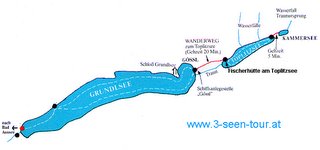Hitler's lake
Exactly 42 years ago, on October 31st 1963, the lifeless body of Alfred Egner, a 19-year-old scuba diver from Munich was found at the bottom of Lake Toplitz (Toplitzsee), in the Steiermark region of Austria. Three weeks earlier, on October 5th, shortly before midnight, he and two older men had come to find something at the bottom of the lake. Egner never made it out alive.
 Toplitzsee is a fascinating lake quite high up (718 m.) in the Austrian Alps not far from Bad Ischl, a watering place favoured by the Austro-Hungarian emperor Franz Joseph and his wife Elisabeth. It can only be reached from one side, driving along Grundlsee, in a rather wide and sunny valley dotted with villages. As one approaches Toplitzsee the valley becomes narrower and when one reaches Gössl, at the end of Grundlsee, the road ends and one has to take a 20-minute walk to reach Toplitzsee.
Toplitzsee is a fascinating lake quite high up (718 m.) in the Austrian Alps not far from Bad Ischl, a watering place favoured by the Austro-Hungarian emperor Franz Joseph and his wife Elisabeth. It can only be reached from one side, driving along Grundlsee, in a rather wide and sunny valley dotted with villages. As one approaches Toplitzsee the valley becomes narrower and when one reaches Gössl, at the end of Grundlsee, the road ends and one has to take a 20-minute walk to reach Toplitzsee. The lake is over 100 meters deep and as it's not very wide the mountain-sides plunge into the water quite steeply. In fact the only accessible side is where the Fischerhütte am Toplitzsee is marked on the above map: the only way to get safely to the other end, and take the short walk to Kammersee, is to go by boat. Even the waters themselves are treacherous:
The lake is over 100 meters deep and as it's not very wide the mountain-sides plunge into the water quite steeply. In fact the only accessible side is where the Fischerhütte am Toplitzsee is marked on the above map: the only way to get safely to the other end, and take the short walk to Kammersee, is to go by boat. Even the waters themselves are treacherous:After 30 feet, the sun goes dark. Below 100 feet, the water is nearly freezing. At 348 feet, the bottom comes into view. There is no life (no plants and no fish) because there is no oxygen in the water.Additionally there is a thick barrier of logs floating near the bottom. It is therefore easy to understand why the Nazis considered it an ideal hiding place - so ideal, in fact that more than 60 years later the lake has still not given up many of its secrets.
While there is some debate about how seriously the Nazis considered creating the so-called Alpenfestung- an Alpine area where they would make a last stand - there seems no doubt that Nazi officials did in fact drop scores of metal boxes into the lake during the waning days of the Third Reich. If it was not done with a view to organizing the Alpenfestung, it might have been to hide damning evidence or valuables for later retrieval. Part of these crates were recovered starting in 1959, and proved to contain counterfeit British banknotes which had been intended for Operation Bernhard.
 The banknotes pictured above (source) were recovered in an otherwise inconclusive expedition in 2000. The idea behind Operation Bernhard was three-fold: to enable the cheap acquisition of raw materials for the war effort (in neutral countries), to destabilize the British economy and to pay the salaries and expenses of German spies and operatives abroad. The scale, humongous: 8.9 million banknotes were printed, with an overall value of £134.6 million, just £2.4 million short of the total gold reserves of the Bank of England, which in 1933 amounted to £137 million. Furthermore, if one takes into account the devaluation (in neutral countries) of the Reichsmark during the war, the total value of the counterfeit pound notes amounted to RM 5.4 billion. But the notes were printed by selected inmates at the Sachsenhausen concentration camp, and their covert sabotage ensured that there were so many delays that the notes were ultimately of little use: most of them were dumped into Lake Toplitz.
The banknotes pictured above (source) were recovered in an otherwise inconclusive expedition in 2000. The idea behind Operation Bernhard was three-fold: to enable the cheap acquisition of raw materials for the war effort (in neutral countries), to destabilize the British economy and to pay the salaries and expenses of German spies and operatives abroad. The scale, humongous: 8.9 million banknotes were printed, with an overall value of £134.6 million, just £2.4 million short of the total gold reserves of the Bank of England, which in 1933 amounted to £137 million. Furthermore, if one takes into account the devaluation (in neutral countries) of the Reichsmark during the war, the total value of the counterfeit pound notes amounted to RM 5.4 billion. But the notes were printed by selected inmates at the Sachsenhausen concentration camp, and their covert sabotage ensured that there were so many delays that the notes were ultimately of little use: most of them were dumped into Lake Toplitz.Over the years there have been many diving attempts in Lake Toplitz with varying degrees of success, some official, some not, and many illegal.
In 1947 a US navy diver became entangled in Lake Toplitz's many submerged logs and drowned.If this book (in German) is to be believed the events surrounding Lake Toplitz are even more sinister than is commonly believed. According to the authors a string of at least eight unexplained deaths occured between 1946 and 1963 involving German tourists (most of whom had been members of the SS). Though I haven't read the whole book, from the excerpts that are online it becomes clear that only a small part of the reams of SS documents that were found at the bottom of the lake, together with the counterfeit pound notes, by the 1959 Stern magazine expedition (and then confiscated by the Austrian authorities) have been made public. Whether in the hands of the Austrian government or still lying at the bottom of Lake Toplitz, the authors seem to believe that there is compelling evidence (apparently confirmed by the intense interest taken in the lake by former high-ranking SS officers) that valuable information - about the Swiss bank accounts into which the Nazis poured an estimated $750 million (at 1945 values) - was part of the loot sunk into the lake.
Then in 1959 a team financed by the German magazine Stern had more luck, retrieving £72m in forged sterling currency hidden in boxes, and a printing press.
The currency, it turned out, was part of a secret counterfeiting operation, Operation Bernhard, personally authorised by Adolf Hitler to weaken the British economy.
Nazis and Nazi sympathisers who had retreated to the Austrian Alps intending to fight a last-ditch guerrilla battle apparently dumped the currency to prevent its discovery.
In 1963 the Austrian government imposed a ban on explorations after another diver, led to the lake by an SS officer, drowned during an illegal dive. More recent expeditions have had mixed fortunes.
In 1983 a German biologist accidentally discovered more forged British pounds, numerous Nazi-era rockets and missiles that had crashed into the lake, and a previously unknown worm.
The last diving team to explore the lake, in 2000, had less luck. After a three-week search in an underwater diving capsule they came away with nothing more than a box full of beer lids, apparently dumped in the lake as a practical joke.
What is certain is that there are some unexplained circumstances around the death of Alfred Egner: his companions, who included a former SS official, in fact did not report his drowning until 20 hours later when they had arrived in Munich (as corroborated here by ZDF). They were convicted for involuntary manslaughter and served five months in prison, though the court heard from forensic analysts (according to this; see footnote 1 here) that the safety line to which Egner was tied had not ripped, as claimed by one of the defendants, but had been cleanly cut.
At any rate in the coming months the mystery of whether there is in fact anything else (more documents, gold, diamonds etc.) in the depths of the lake may finally be cleared up:
The Austrian government has given a US team permission to make an underwater expedition to the log-infested bottom of the lake.In a sense it will be a pity if the aura of mystery is removed (particularly for local tourism!), but there is a good chance that it will be possible to draw some reasonably certain conclusions at the end of this expedition. After all, the lake is not that large (consider that Loch Ness is 37 km long and reaches depths of 226 meters) and the explorers seem to be organized, well-financed and determined. Good luck to them.
[...]
Later this month Mr Scott will begin a detailed underwater survey of the 107 metre (350ft) deep lake, though there is profound official scepticism that there is anything left to find.

No comments:
Post a Comment